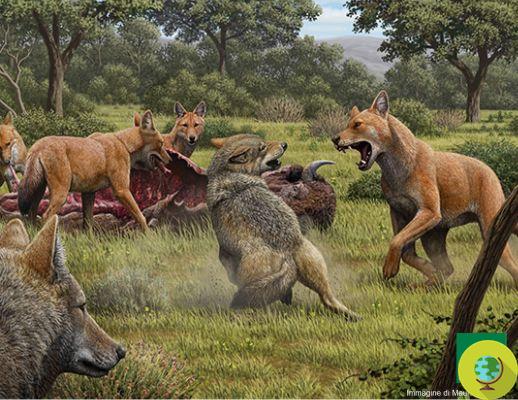
A new DNA study found that these animals were not wolves at all, but the last of a lineage of dogs that only lived in North America
He is about to end up run over, his mother saves himThe direwolves are iconic animals. These creatures lived and became extinct in the Pleistocene, about 13 thousand years ago but in recent years their fame has been dusted off by the Game of Thrones series. However, a new study of their genetics surprised paleontologists to find that the animals weren't wolves at all, but rather the last of a lineage of dogs that evolved in North America.
The direwolves, scientifically known as (Canis dirus) made known by the Game of Thrones saga, were common about 13 thousand years ago in that area, then they became extinct. But they "separated" from the wolves nearly six million years earlier, remaining only remotely related.
This is revealed by new research conducted at the University of Adelaide. According to scientists, such creatures were very different from other canine species such as coyotes and gray wolves who were unable to reproduce with each other. Previous analyzes, based only on morphology, had led scientists to believe they were closely related to gray wolves but now for the first time, ancient DNA has been sequenced from five fossils from Wyoming, Idaho, Ohio and Tennessee, some dating back over 50.000 years. Analyzes showed that they were very distant "cousins" of gray wolves.
The research was conducted by the University of Adelaide, Durham University in the UK, Ludwig Maximilian University in Germany and the University of California at Los Angeles in the United States.
Their DNA revealed the complex history of these ice age predators. Thanks to the collaboration of 49 researchers from 9 countries, the DNA of wolves was analyzed along with those of many different species of similar canids. Analyzes suggested that, unlike many canine species that apparently migrated repeatedly between North America and Eurasia, they will only live in North America for millions of years.
Although they overlapped coyotes and gray wolves in North America for at least 10.000 years before their extinction, there is no evidence that they interbred with these species.
Lead co-author, Dr Kieren Mitchell, of the University of Adelaide's Australian Center for Ancient DNA, explained:
“The wolves in question are sometimes portrayed as mythical creatures - giant wolves prowling in bleak frozen landscapes - but the reality turns out to be even more interesting. Despite the anatomical similarities to gray wolves, our genetic results show that these two wolf species are much more similar to distant cousins, such as humans and chimpanzees. While ancient humans and Neanderthals appear to have interbred, as do modern gray wolves and coyotes, our genetic data have provided no evidence that the cruel wolves interbred with any living canine species. All our data indicate that they are the last surviving members of an ancient lineage distinct from all living canines. "
Dr. Angela Perri, of Durham University's archeology department, shares the same opinion that these mythical creatures that became a pop culture icon thanks to Game of Thrones now have fewer secrets.
Also nicknamed as "cruel wolf", this animal is one of the best known carnivores of Pleistocene America, extinct about 13.000 years ago. Scientifically known as Canis dirus, which means "scary dog", it hunted large mammals such as bison. The team suggests that the stark evolutionary divergence of 'cruel' wolves from gray wolves places them in an entirely different genus, as paleontologist John Campbell Merriam first proposed over 100 years ago.
“When we started this study, we thought they were just 'reinforced' gray wolves, so we were surprised to learn how genetically different they were as they probably couldn't have interbred. Hybridization between Canis species is believed to be very common, this must mean that such animals have been isolated in North America for a very long time to become so genetically distinct "concluded senior author, Dr. Laurent Frantz, of the Ludwig Maximilian University of Munich.
The study was published in Nature.
Sources of reference: University of Adelaide, Nature
READ also:
- Goodbye Yuki, the hybrid wolf with husky and German shepherd who remembered the direwolves of Game of Thrones
- Game of Thrones: a crowdfunding campaign to save the wolves and die in the novel (VIDEO)
- Game of Thrones: the dog and cat bed inspired by the Iron Throne


























